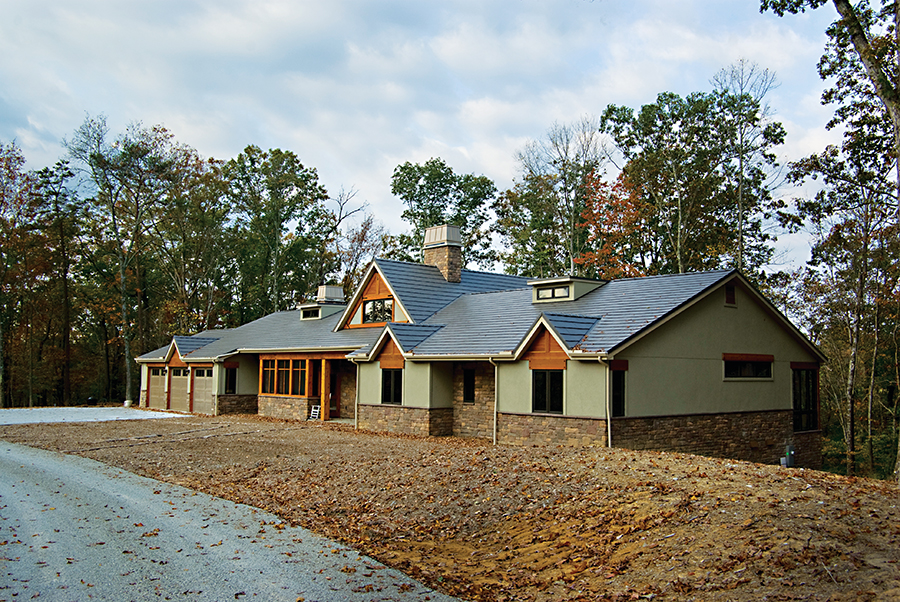Natural beauty takes on a new meaning at the home of Jason and Halcyon Moses, where environment awareness meets modern luxury.
By Katherine Reasons-Pyles
HQ 73 | SPRING 2011
There is more than meets the eye at the home of Jason and Halcyon Moses. While you may be taken aback by the picturesque view from the home’s tall glass windows, what you might not notice is that the view is as energy-efficient as it is beautiful, due to the strategic positioning of the house to allow in as much natural light as possible while minimizing solar heat gain. The gleam of the solid brass kitchen hardware may catch your eye, but you might never realize that all of the home’s drawer pulls, cabinet knobs and doorknobs were made in the U.S. from nontoxic, recycled metal. You could relax for hours near one of the home’s fireplaces without ever knowing that the firewood was stockpiled from every tree that was cut down during the construction of the home, or that the fire burns so efficiently that hardly any smog is produced — or that ductwork hidden inside the chimney makes it possible to enjoy the fire’s warmth in entirely different areas of the house simultaneously. And when you have a drink of water, you may notice its pure, clean taste, but would it ever cross your mind that the water you are drinking is rainwater collected from the home’s metal roof?

“People always say, ‘Your home is so unique,'” Halcyon said, “but all I know is that this home is us. If we were a house, this is what we would look like. We spent years looking at stock plans, a year forming our own plan concept — and another year working with our architect, who took our concept and made it a real home that fits our family’s lifestyle, aesthetics and environmental goals. Jason and I have a long-term vision of living in this house forever. We never want to move or build again, and we knew that from the very beginning. We knew if we were going to do this, we wanted to do it right and do it once.”
Jason and Halcyon are owners of an innovative “green home” in a secluded Huntington neighborhood. From recycled-content drywall to Energy Star appliances to sustainably harvested wood, the Moses family carefully thought out every aspect of the home before construction even began.

“It was like we had already lived in this house before we broke ground. We analyzed everything — how we poured the walls, what type of support system we used for the peaks in the ceiling, the spray foam insulation, the heating system,” Halcyon said. “We made a lot of environmentally friendly decisions, but not frivolously. If we spent more on something, it was very purposeful.”
Jason and Halcyon worked with architect Ed Weber of Silling Associates. Weber is a LEED Accredited Professional whose experience includes residential and commercial construction. LEED accreditation recognizes those with expertise in improving energy savings, reducing CO2 emissions, increasing water efficiency and improving indoor environmental quality.

“My architect went with me to pick out tile, to pick out carpet, to pick out the light fixtures — Ed’s vision was so fine-tuned to the final product that we couldn’t have done this without him,” Halcyon said. “He helped us think of every last detail.”

Although Jason and Halcyon had already researched a great deal before getting in touch with Weber, Weber said others looking to “build green” do not have to be so well-versed in the field.
“If somebody comes in with absolutely no understanding of green homes, going to an architect and asking them to educate you is a perfectly acceptable way of getting yourself into the green building market,” Weber said. “Halcyon had done so much research on her own that we had a great dialogue from the first day we met. She’s as well-informed as anybody that you’ll meet, but that’s not a prerequisite for green building at all.”

Jason and Halcyon also praised the work of their contractor, Jarrett Construction, who won the 2010 “Excellence in Construction” award for a residential, single-family project issued by Associated Builders and Contractors, WV Chapter.
The Moses family’s home design allowed for a geothermal heating and cooling system, which brings climate-controlled air into the house from 200 feet below the earth’s surface. Because temperatures beneath the earth stay at around 50 degrees Fahrenheit no matter what the temperature is above ground, geothermal systems use much less energy than traditional HVAC systems. The floor plan also provided for an enormous maintenance room on the lower level of the house, where for the first time all of the home’s environmentally friendly solutions are in plain sight.

“The maintenance room is my favorite room of the house,” Halcyon said. “It’s like the man behind the curtain.”
The maintenance room houses the geothermal compressors, water filtration system, ductwork and plumbing. An air exchanger brings in fresh air from the outside to replace stale air from the inside of the home. To make warm showers a little more energy-efficient, the cold water pipe coils up to the shower around the wastewater pipe — so, as the cold water travels up, it is heated by the wastewater traveling down. Halcyon said the innovative solutions are endless when it comes to building an eco-friendly home.
“That’s what’s so great about this movement,” she said. “The light bulbs are coming on, and people are getting excited. It’s like, ‘Wow, if I just make this one change — if I just do this or if I just do that — I can really save money and energy.'”

Once Jason and Halcyon finalized their floor plan with Weber and chose the lot, located in an isolated area and surrounded by woods, they began to consider each room of the house in terms of how it would affect the environment — as well as how it would affect their own well-being.
“It’s amazing what can end up in your air from your furniture, from your carpet, from your paint, even from your hand soaps,” Halcyon said. “In many cases the pollution inside the home can be greater than the pollution outside. If you’re going to build an environmentally friendly home, you have to ask the questions — where do these things come from, what are they made of, what could they possibly do to me — before you make any purchasing decision.”

The Moses home features unstained hickory floors, VOC-free paint (VOC stands for “volatile organic compounds,” found in many paints and stains), all-natural wool carpet and energy-efficient lighting and appliances. The kitchen floor is cork, which Halcyon said “is sustainable harvesting in its purest form.” Cork is made from bark that has been scraped from a live tree; the tree produces many layers of bark in its lifespan. An added bonus is that cork floors are naturally cushiony, making them perfect for a kitchen application. The granite countertops which appear throughout the home were all “rescued” from the salvage yard at Creative Kitchens, and Halcyon discovered the sinks in the children’s bathrooms at Habitat ReStore. The house’s thermostat and light switches are connected to an electrical system that can be accessed remotely, in the rare instance that one of the Moses clan forgets to turn off the lights or adjust the thermostat before leaving the house. But perhaps the most innovative and surprising solution is the family’s water source. The Moses home is not hooked up to city water; instead, the family relies entirely on an in-home filtration system that uses rainwater collected from the roof of the house.

“All of the rain that hits our roof goes into two 2,500-gallon cisterns beneath the house,” Halcyon said. “We have a rain gauge that monitors how much water we’re collecting. If we’re getting a little low, we take two-minute showers.”
Halcyon said relying on rainwater has led her entire family to appreciate water as a precious natural resource.
“Of course this requires more work, but I love being more connected with nature,” she said. “When you turn on the faucet and don’t think about where all that water is coming from, you don’t realize how much you are using. My kids think this is pretty cool, too; I will overhear them telling their friends, ‘We drink rainwater.'”
And it is for their children that Jason and Halcyon said nearly every decision about the house was made.

“Ninety percent of what we did was for our kids,” Halcyon said. “Our decisions concerning air quality, water quality, materials made in the U.S. versus overseas — all of those were made in order to provide our children with the healthiest life possible. The environment isn’t this separate entity that has no effect on us; the environment is us. If you don’t have fresh air and you don’t have fresh water, you don’t have life. That’s what we’re striving for.”
“It’s about doing the right thing for your family,” Weber echoed. “It’s about keeping the toxins out of reach. For me that is an apolitical position. It’s an apolitical position to say that I want to have the most energy-efficient house I can get. It makes sense for me, my family and my pocketbook.”





